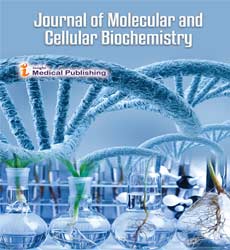Lipid Bilayer and the Membrane Regulation
Kumar Sujathan*
Division of Cancer Research, Regional Cancer Centre, Thiruvananthapuram, Kerala, India
- *Corresponding Author:
- Kumar Sujathan Division of Cancer Research, Regional Cancer Centre, Thiruvananthapuram, Kerala, India E-mail: ksujathan@gmail.com
Received Date: September 03, 2021; Accepted Date: September 17, 2021; Published Date: September 24, 2021
Citation: Sujathan K (2021) Lipid Bilayer and the Membrane Regulation. J Mol Cell Biochem Vol. 5 No.4: 4
Description
Every cell is surrounded by a membrane that provides structure and allows nutrients and wastes to move into and out of the cell. The bilayer or double membrane’s priority is keeping the contents of the cell distinct from the outside world. The cell's outside is primarily water, while the cell's inner is mostly water and other compounds, such as carbohydrates and proteins, which serve as receptor sites for other messenger molecules. Molecular communication signals can move from the outside to the inside of the cell due to interactions with the cell membrane. Lipids and proteins are the two types of molecules that make up cell membranes. The proteins act as enzymes, transport chemicals, and provide the membrane its particular features. Lipids are the building blocks of the body. The cell's structural integrity is provided by lipids. There are two types of lipids in the membrane: hydrophilic (water soluble) and hydrophobic (not water soluble or water insoluble). The nonpolar long hydrocarbon chains of two fatty acids make up the hydrophobic portion of the lipids. The fatty acids are linked to glycerol as esters. The term phospholipid reflects the fact that the third-OH group on glycerol is ester linked to phosphate. Because the phosphate ester moiety of the molecule is polar or even ionic, hence water is soluble. Membrane lipids can regulate membrane protein function through a variety of ways, including specific chemical interactions between proteins and individual lipid molecules as well as non-specific interactions between proteins and the bilayer.
Regulation of lipid bilayer
Stearic acid (a fatty acid) and phosphatidylcholine (a phospholipid) are lipids that are made up of chemical groups that have polar head and non-polar tail. The polar heads are hydrophilic, signifying they are water soluble, whereas the nonpolar tails are hydrophobic, simply means they are water insoluble. Lipid molecules with this composition form aggregate structures like micelles and lipid bilayers spontaneously, with their hydrophilic ends directed toward the watery medium and their hydrophobic ends insulated from the water. The importance to regulate hydrophobic interactions among membrane lipids and proteins is represented in the organization of a cell membrane. The energy penalty for exposing hydrophobic surfaces to water induces lipid molecules to form a bilayer, with the hydrophilic lipid head groups exposed to the aqueous solution and the acyl chains sequestered in the hydrophobic core of the bilayer. The side chains of proteins that are exposed to aqueous solution are hydrophilic, while those on the external surface of the proteins' trans-membrane domains (TMDs) are hydrophobic. Due the presence of bilayer in the cell membrane or plasma membrane of the cell it help to regulate the fluidity of the cell and helps to regulate the homeostatic of the cell .the asymmetric structure of the bilayer used help different phospholipid and protein to active the enzyme. Its focus has been on bilayer physical characteristics' non-specific modulation of membrane protein function. The chemical heterogeneity of biological membranes and the complexity of protein–bilayer boundaries continue to be obstacles to a mechanistic understanding, but the hydrophobic coupling mechanism provides a framework for investigating the energetic coupling between membrane proteins and their host bilayer. Furthermore, the continuum theory of elastic bilayer deformation lays the groundwork for linking molecular processes to changes in bilayer physical properties.
Open Access Journals
- Aquaculture & Veterinary Science
- Chemistry & Chemical Sciences
- Clinical Sciences
- Engineering
- General Science
- Genetics & Molecular Biology
- Health Care & Nursing
- Immunology & Microbiology
- Materials Science
- Mathematics & Physics
- Medical Sciences
- Neurology & Psychiatry
- Oncology & Cancer Science
- Pharmaceutical Sciences
